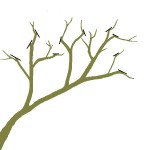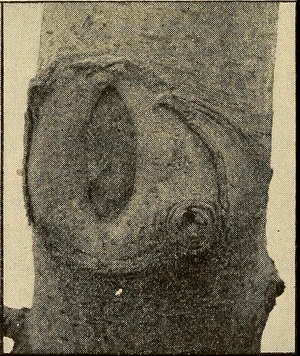(Stephen used to ride BMX bikes as a kid.)
Pruning your trees in important for consistent growth and ease of harvest. Pruning is more of an art than a science and like anything else takes practice. Honestly though, once you get started, it is easier than you think. The other day I got the opportunity to record my local master gardeners giving a training class on pruning. They were gracious enough to allow me to provide the recording for you. I encourage you to watch the videos, then read the rest of the article, then go practice. Happy pruning!
Training vrs Pruning

You can train a young tree to take the shape you want by using a hoop.
When possible you should try to train the branches of your tree to grow in the direction you want instead of cutting the tree into the shape you want. You can use cloth and rope to pull a young branch in the direction you want it to grow. Make sure that the material contacting your tree is larger than 1 inch to avoid damaging the bark.
Why Prune
Proper pruning will allow you to reach the fruit easier, give the tree leaves and fruit more sun exposure, and help your tree produce larger fruit instead of a larger canopy. Pruning also helps prevent diseases caused by bark damage from crossed branches.
Tree Terms
Before we get started please look over this diagram of tree terms, so you can have a better understanding of the parts of a tree.


Tree Shapes
When you prune you have 2 main goals. The first is to increase the amount of sunlight to hit the branches. The second is to make it easier to pick. The two main shapes are Open Center or Vase and Central Leader, but there are others like Espalier and Modified Leader.
- The goal of Open Center or Vase pruning is to get the branches to grow outward and upward, with the central trunk being really low. So the tree looks like an upside down cone. Peaches, Apricots, Nectarines, and Plums do well with this style.

Examples of Open Center Pruning
- The goal of Central Leader pruning is to make the tree grow straight up as possible with multiple “shelves” or canopy levels. Leaving plenty of space between the canopy levels will allow plenty of sunlight to the branches. Fruit trees like Apple, Cherry, Pear, Pecan, Plum do best with this technique.

Example of Central Leader Pruning
- Modified Leader is like Central Leader, except you create 2 or 3 leaders. This technique is sort of a blend of Central Leader and Vase.
- Espalier can be done to train or prune a tree flat against a wall or a fence line.

When to Prune
Prune in late winter before the spring growth starts. During the winter, the trees energy is stored in the roots, so any pruning you do will not waste sap and energy. You don’t want to trim in fall or early winter because the cut wounds will be exposed for a longer time before the spring growth can start healing the tree.
Do not prune more than 25% of the canopy. If you need to prune more, wait until next year. If you cut too vigorously you could shock the tree and reduce its growth and productivity for years. Also, if you prune too much, you will get a large amount of suckers and watersprouts in the spring.
A Note About Fruit Trees
Fruit trees tend to develop the buds for next years flowers and fruit in the fall. This means that when you are doing your winter pruning you will be removing branches and reducing the amount of fruit you will get the following spring. For specifics based on the variety of tree you are pruning check out this article.
Sanitize Your Cutting Blade
 Before you get starting pruning, you should prepare a sanitizer for our cutting tools. This sanitizer will help prevent the spread of viral or fungal diseases between your trees. Use it to wipe down your tools between trees. You can just mix up 1 part bleach with 99 parts water into a five gallon bucket or about 1.25 oz bleach for 1 gallon of water or 4 oz of bleach for 3.2 gallons of water.
Before you get starting pruning, you should prepare a sanitizer for our cutting tools. This sanitizer will help prevent the spread of viral or fungal diseases between your trees. Use it to wipe down your tools between trees. You can just mix up 1 part bleach with 99 parts water into a five gallon bucket or about 1.25 oz bleach for 1 gallon of water or 4 oz of bleach for 3.2 gallons of water.
What and Where to Prune
After you get your tree into the shape you want, all you need to do is maintain it. This can be done pretty quickly with a winter pruning. Here is a list of things you should prune:

- Suckers are branches that grow off of the roots.
- Watersprouts are like suckers, but they grow straight up in the interior of the tree.
- Weak V-Crotches are places where the secondary branch is coming off of the primary branch at steep angle. This creates a weak bond and has the highest chance of breaking in the future. You want the crotches to look more like a U-shape.
- Cross limbs or limbs that cut across the tree and run into other branches should be removed.
- Vertical growth either up or down should be removed to encourage outward growth for better light penetration and picking.
- Stubs and broken branches should be removed to prevent disease and remove pest entry points.
- Double leaders or competing leaders should be removed. This causes competition and dwarfed fruit. Pick the strongest leader and remove the weak one.
- Whorls are competing branches at the same level of the primary leader. Similar to double leaders, this will cause competition.
How and Where to Make Your Cuts
When you cut small limbs, laterals and young scaffolds, you want to cut next to a lateral bud as shown here. Cuts ‘b’ through ‘f’ are wrong and cut ‘a’ is correct.

When cutting a large branch off of a tree, you need to be careful that the branch doesn’t break and strip the bark. Follow these steps when making your cuts.
Cut 1: Cut under the branch about 10% to 25% through. Be careful not to get your saw blade pinched. This undercut prevents the bark from peeling back and the branch from splitting. Cut 2: Cut down a few inches out from your undercut all the way through the branch. Be careful, it may break before you get all of the way through.
Cut 2: Cut down a few inches out from your undercut all the way through the branch. Be careful, it may break before you get all of the way through.

Cut 3: Cut up from the bottom next to the collar. Don’t cut off the collar, but don’t cut too far out leaving a stub either.

The collar will grow out and around the cut branch healing the tree. Here is an example:
Summer Pruning
In general you should not prune your trees in the Summer, but if this is the first or second year and you are still shaping your tree it is OK to remove young branches and buds that are growing in the wrong direction. Just don’t get carried away. The other thing that is ok to prune anytime is a sucker coming of the roots of your tree. You also may want to prune internal shoots or watersprouts that will damage the tree if left until winter.
Maintaining and Reducing the Size of Your Tree
Do not make topping or heading cuts. Although this type of pruning or trimming is OK for hedges and shrubs you shouldn’t use it for your fruit trees. It will only encourage a large amount of suckers and watersprouts. Here is a picture of what not to do:

For your fruit trees you want to use a drop crotch pruning technique instead. This is done by making your cuts down by the nearest joint. See diagrams below:



Pruning a Neglected Tree
For neglected trees, make a few large cuts rather than many small ones. To get a neglected to tree to the proper shape should take at multiple years. The first year you should make 3 to 4 large cuts, to open up the tree and allow sun to reach the scaffold branches you want to keep. The second year you should thin your scaffolds so they allow even more sun in. The following years you will put the final touches and maintain the tree.
Neglected trees will take a few years to get back into shape. Be patient. For the first year make a few large cuts rather than many small ones.



The following year, go back through the remaining branches and trim them back as well. Use the same idea of a few large cuts, rather than many small ones.



Other Tips
Know what kind of wood your fruit grows on. Fruit can grow on this year’s growth (new wood) or last year’s growth (old wood). Knowing this will help you decide what to cut off and what to keep. Refer to this article on trees for info on what kind of wood the fruit grows on for specific trees.
Do not prune more than 25% of the canopy. If you need to prune more, wait until next year. If you cut too vigorously you could shock the tree and reduce its growth and productivity for a couple of years. Also, if you prune too much, you will get a large amount of suckers and watersprouts in the spring.
References
http://www.avtreefarm.com/pdf/Fruit%20Tree%20Pruning%20Basics.pdf
http://www.ces.ncsu.edu/depts/hort/hil/ag29.html
http://www.arborilogical.com/tree-knowledge-articles-publications/dangers-of-over-pruning/
http://www.homelife.com.au/gardening/features/fruit+trees+winter+care,15295




Do you prune the shafts on which the fruit grows? If so, when do you prune such shafts?
Can you prune the water sprouts at any time?
Dave, thank you for your question. You can prune branches that would bare fruit. I would wait until late winter (Jan early Feb) to do all pruning. Including suckers and water sprouts. You can also prune suckers and water sprouts early in the spring when the first start to grow.
This is a wonderful article on pruning fruit trees. For the first time, I am not left with more questions than answers! Thank you!